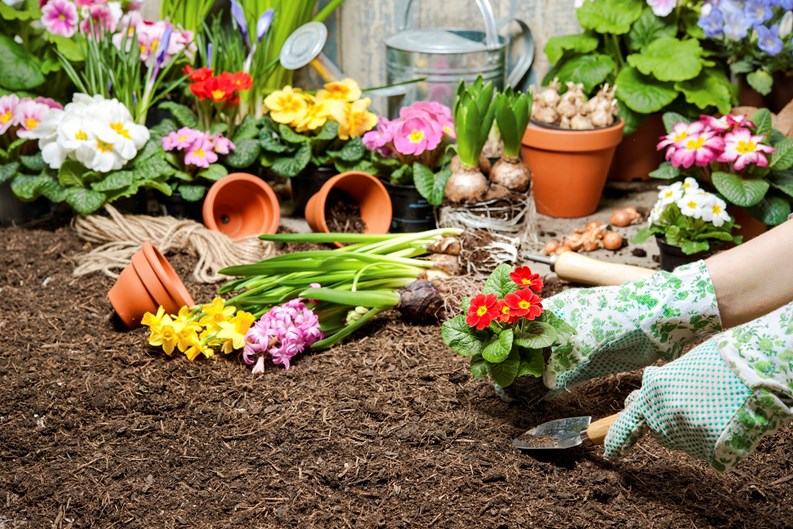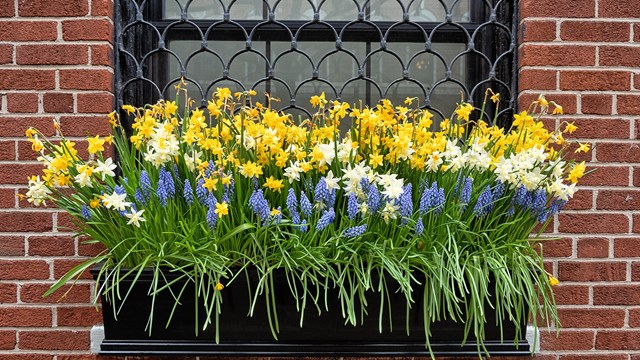The New York City Department of Parks and Recreation proudly, and quite rightly, boasts about the many film scenes that have been set in the numerous parks and green spaces in the five boroughs. From Washington Square Park in When Harry Met Sally to Central Park in Manhattan, the Big Apple's flora looks great on film. And whether your popcorn-butter-covered green thumb was inspired by the movies, or you’re a city transplant who grew up around gardens, many of us feel the desire to dig our fingers into some dirt, plant a few seeds and watch them grow because, along with the coming warm weather, live flowers and greenery have serious mood-boosting power.
Flowers also have the ability to liven up almost any façade, and add appeal (and potentially value) to both urban and suburban properties. But, you can’t just slap a fern on your frontage and call it a day. Climate, placement, species, and, you know, how to actually keep the things alive all matter when considering landscaping and planting in urban settings.
What, and Where?
First things first, you’ve got to figure out what is best to plant, says Jeanette Dragonetti, ASLA, a landscape designer at Dragonetti Brothers in Brooklyn. “The biggest challenge is selecting the right plant for your space.” As much as you like roses, your desire for them to grow doesn’t mean they are going to grow, let alone thrive, on your small balcony space that gets very little sun but lots of brownish water dripping from the drain pipe above.
“Because of so many tall buildings in New York, bright, open sunlight is a rarity, as is easy water access,” says Rebecca Bullene, founder of Greenery NYC. “We see many spaces in our work that are closed-in, shady courtyard spaces that building residents would like to make lush gardens, but because there is little light and no reliable water access, it can be a challenge to meet those goals.”
Luckily, that doesn’t mean that entire genus and species are out of consideration. “I think any plants that need a tremendous amount of sun and water—like most tropical plants—aren't a good choice,” continues Bullene. “I tend to steer clients away from using too many annual plants as well, as they have to be replaced every year. You'll see much better long term results choosing the right plant for the right place, planting it once, and watching it grow for years to come.”
Even though city dwellers have the inherent challenge of being in a highly populated, weather-battered urban center, there are countless options of flowers that can withstand what New York City throws at them. Bullene suggests the shade-friendly Allegheny pachysandra (Pachysandra procumbens), Creeping phlox (Phlox stolonifera), Foam flower (Tiarella cordifolia), and Coral bells (Heuchera americana). For those gardens that receive consistent direct sunlight, good flower options are Cat mint (Nepeta Racemosa), Iris, Rugosa roses, and asters.
For her part, Dragonetti recommends one of her favorite perennials: coneflowers (Echinacea). “These come in tons of different varieties and colors and are easy to grow,” she says. “Some do well in sun, while other flourish in some shade. Bluestars (Amsonia) are perennials I tend to use a lot, because they're full sun and drought tolerant. Both of these perennials are super hardy!”
How Does Your Garden Grow?
After you’ve selected the appropriate blossoms for your patch of green, think about the real estate itself and don’t try to diversify too much. “Gardens look best when there are groupings of plants, not just lots of different things,” says Dragonetti. “Try to make a more natural landscape where there would be areas of five to seven plantings, not individual plant types mixed together in ones and twos. Often the most impressive gardens give a sense of abundance, balance, and lushness, and that is achieved with planting many of the same type of plant in cohesive patterns. Better to have just a few types of plants in your building's entrance garden planted densely than 20 different types all competing for attention.”
You should also take into consideration the irrigation system, say the planting pros. “The most common mistake I find when evaluating a landscape that is not doing well is that the irrigation system isn’t properly coordinated for the plants' water intake—or there's no irrigation system in place at all,” Dragonetti continues. Not enough water, and your garden will die; too much and you’ll drown it. The 'system' also includes factors like best time of day to water (usually the morning so your garden isn’t left damp overnight), using or not using mulch (it can help keep soil moist) and adjusting your watering schedule based on the outside temperature (watering more when it’s hot out, less when it’s cooler).
Gardens are, of course, meant to be admired, but take care not to let your fans trample, trash or—if they have four legs—pee on your plants. “Dogs and people are the biggest threats to plants in front of buildings or within tree pits,” says Bullene. “We often see people litter or let their dogs relieve themselves there, and that can be harmful for plant displays. And of course there is also the occasional well-meaning child picking a flower for mom, which is adorable, but not good for residents trying to bring color to their entrance garden.”
Bullene suggests that when it comes to gardens, lead by example—i.e. prune and tidy for the garden you want, not necessarily the garden you have. “We've found that keeping the area really clean helps signal to people that it is a well-loved space that should be treated well.” She further advises that a layer of mulch two to three inches deep may protect roots from dog waste.
Smaller, but still dangerous to your garden is the Asian Long-Horned Beetle, which Dragonetti points out have currently been targeting maple, elm, willow, birch and ash trees in Brooklyn, Queens, Manhattan & Staten Island. All of our experts note that gardeners should be aware of the potential (and perhaps unavoidable) impact and damage caused by city pollution, salt from winter sidewalks and car traffic.
Overall, the success of your succulents, sunflowers and sage depends on “selection, placement and care,” says Manhattan-based Chelsea Garden Center's president David Protell. And some of the biggest challenges are faced before you even sink your trowel in the dirt. Protell advises gardeners to really understand the selection process and not assume that “Internet research translates into what you can use. Each garden has its unique sun, drainage, and exposure issues which need to be properly accessed.”
Learn the Roots
Luckily, there are a lot of people out there passionate about perennials and are eager to help aspiring gardeners. “Brooklyn Botanic Garden has great books and articles on their website (and an amazing library for those who still like paper and ink!), and there are many talented garden designers out there that offer consultation services as well,” says Bullene. “For those that really feel overwhelmed sometimes bringing in a professional to get them started on the right track may be the best way to ensure long term success.”
If you prefer to bring in the experts rather than read the books, any properly accredited, pro landscaping firm can offer solid advice for small and large projects, and their responsibility to a co-op or condo building taking on the project is to set realistic goals and a working budget. “Too often, plantings are conceived as an afterthought with no true budget in place,” says Protell.
“We have a seven to nine month growing season that could start with hardy bulbs coming up in late March or April, followed by five to six months of flowering annuals, then on to fall and holiday dressing. Building staff following watering instructions and a monthly or quarterly maintenance program will ensure that fertilizing, pest control and pruning are properly implemented. All of the above combine for a successful enhancement of the property.”
In order to get the best result from your relationship with a landscaping firm or designer, Bullene suggests that, before even meeting with a designer, the gardening or landscape committee should meet to outline their goals. “Do they want a space for edibles or growing flowers, or just stately evergreens? Do they want to care for the garden themselves or pay for professional maintenance? Clearly articulating how involved the committee wants to be from the outset can help a designer come up with a plan that best fits the group. If you have a committee of avid gardeners eager to get their hands dirty, a designer can put together a plan that will give them lots to work on throughout the season with deadheading and pruning. If you have a committee that doesn't have the time or inclination for that level of involvement, a designer can put together a low maintenance plan that focuses more on evergreen shrubs or plants that grow slowly, or propose a professional maintenance plan.”
That plan will plot out exactly what a year of your garden looks like and the work required to achieve those gardening goals. Bullene explains that a first visit in the spring will assess and clean up winter damage and perform prep work for plans ahead; a second visit in the late spring or early summer is for planting; the third visit in late summer is to trim, tidy and perform upkeep and the final visit in the fall is meant to prep for the winter to come.
Truly, the number one ingredient to a healthy garden is patience. Less tangible than mulch and less trendy than a pair of gardening gloves, patience is necessary every step of the way. Add a pinch of consistency and you will most likely be on your way for a picture perfect garden. And, when the first green slivers appear through the soil, as Bullene astutely points out, “It’s worth the dirty work.”
Rebecca Fons is a freelance writer and a frequent contributor to The Cooperator.










Leave a Comment